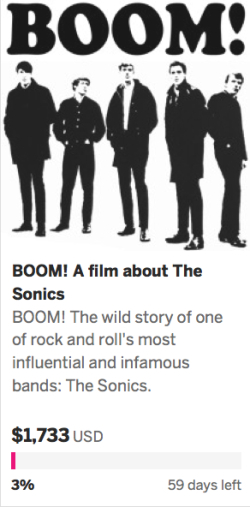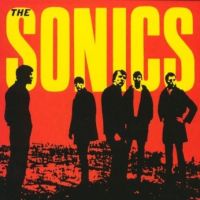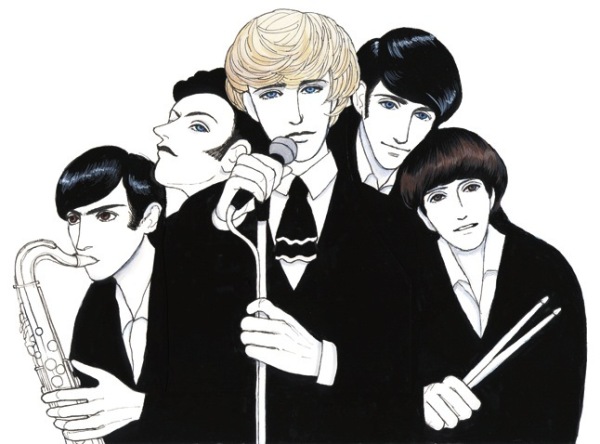Yesterday award-winning director Jordan Albertsen (THE STANDARD) and producer Brian Scott Robinson launched their Indiegogo campaign for their feature documentary BOOM! A Film About The Sonics, which will chronicle this history of the Pacific Northwest proto-punk band’s rise, fall, and unlikely and triumphant return. At once both a completely unknown band and an enduring legendary influence, The Sonics are considered by many to be the Rosetta Stone of punk music.
The Sonics were a clear influence on innumerable bands, including The Hives, Nirvana (“They’ve got the most amazing drum  sound I’ve ever heard.” – Kurt Cobain), The Kinks (“A big part of American history and a rock band that were around way before The Kinks even had a car.” – Ray Davies), and The White Stripes (“Harder than the Kinks, and punk long before punk.” – Jack White), The Cramps, L7, and LCD Soundsystem, among others. Yet despite having an intense fan base in the US , The Sonics may be the most unknown legends in rock history. Unknown, that is, until you leave the US. Much like Rodriguez in Searching For Sugarman, The Sonics have a massive fan base outside the United States and since their reunion in 2007 have routinely drawn rabid crowds in Europe, a place their records were never originally released commercially.
sound I’ve ever heard.” – Kurt Cobain), The Kinks (“A big part of American history and a rock band that were around way before The Kinks even had a car.” – Ray Davies), and The White Stripes (“Harder than the Kinks, and punk long before punk.” – Jack White), The Cramps, L7, and LCD Soundsystem, among others. Yet despite having an intense fan base in the US , The Sonics may be the most unknown legends in rock history. Unknown, that is, until you leave the US. Much like Rodriguez in Searching For Sugarman, The Sonics have a massive fan base outside the United States and since their reunion in 2007 have routinely drawn rabid crowds in Europe, a place their records were never originally released commercially.
Produced with the full cooperation of the band, BOOM! A Film About The Sonics will tell the story of this incredible band. From their humble beginnings in a living room in 1963 Tacoma, Washington (occasionally with mom on guitar!) to signing with Etiquette Records and releasing their now-legendary debut LP Here Are The Sonics, to their disastrous third effort, Introducing the Sonics, the failure of which essentially lead to the band’s breakup. In 1968, the band split up to go their separate ways, only to reunite in 2007, resulting in a steady rise in activity and popularity, culminating in their recent release, This Is The Sonics, one of the best-reviewed albums of the year, receiving 4 stars from Rolling Stone, and with Pitchfork raving “The Sonics are alive and viciously well” and The Austin Chronicle calling the band “…more punk at 70 than a truckload of Sex Pistols 45s.”
PREVIOUSLY: In 1965, Tacoma, Washington’s The Sonics released a debut album of raw-boned, hemorrhagic garage-punk and maximum R&B called, simply, Here Are The Sonics. Exponentially louder, wilder, and weirder than their woolly-bully frat-rock brethren on the SeaTac teen club/roller rink/armory circuit, The Sonics sang about witches, psychopaths, Satan, and strychnine as a social lubricant, along with the more standard themes of hot girls and fast cars, or, even better, fast girls in hot cars. The 12 tracks on Here Are The Sonics capture the needle-pinning, speaker-blowing, tonsil-shredding, balls-to-the-wall mating call of five hormonal mid-’60s teenage savages forever in hot pursuit of Mad Men-era booze-cigarettes-sex-magic and the glorious din that made it all possible.
Fifty years after its release, Here Are The Sonics still sounds, as  /The-Sonics-Here-Are-the-Sonics/”>one wag aptly put it, “as raw as a freshly scraped kneecap.” On the continuum of rock ’n’ roll as a 20th-century art form, Here Are The Sonics remains a vital and important relic, the aural equivalent of a prehistoric cave painting, as primitive as it is seminal. It changed music. More accurately, it changed the people who would change music.
/The-Sonics-Here-Are-the-Sonics/”>one wag aptly put it, “as raw as a freshly scraped kneecap.” On the continuum of rock ’n’ roll as a 20th-century art form, Here Are The Sonics remains a vital and important relic, the aural equivalent of a prehistoric cave painting, as primitive as it is seminal. It changed music. More accurately, it changed the people who would change music.
Jack White called it “the epitome of ’60s punk.” Kurt Cobain said it had “the most amazing drum sound I’ve ever heard…it sounds like he’s hitting harder than anyone I’ve ever heard.” On “Losing My Edge,” LCD Soundsystem’s James Murphy concludes his itemized list of the essential artists in the definitive hipster record collection by invoking The Sonics four times in a row, as if casting a spell.
Feeble national promotion and ham-fisted distribution may have ensured that few outside of The Sonics’ Pacific Northwest stomping ground heard Here Are The Sonics when it was first released, but in the fullness of time its sphere of influence now transcends generations and spans continents thanks to the Esperanto of electrifying noise. MORE

